Just outside Stuttgart in southwest Germany is Ludwigsburg, where you can visit a palace inspired by Versailles with fairytale gardens.

We are fortunate to have visited family friends near Ludwigsburg, Germany on more than one occasion. Each time, a trip to Schloss Ludwigsburg (Ludwigsburg Palace) has been on the menu of things to do. In the summer of 2002, when all the kids were younger, the entire visit was spent in the palace gardens.
This article contains affiliate links and/or references to our advertisers. We may receive compensation when you click on or make a purchase using these links.
Our visit took the form of a private guided tour inside the Palace on a day it was closed to the general public. We even got to visit some places that are normally off limits and see things most people do not get to see. It pays to have friends with connections!
Table of Contents
Touring Ludwigsburg Palace
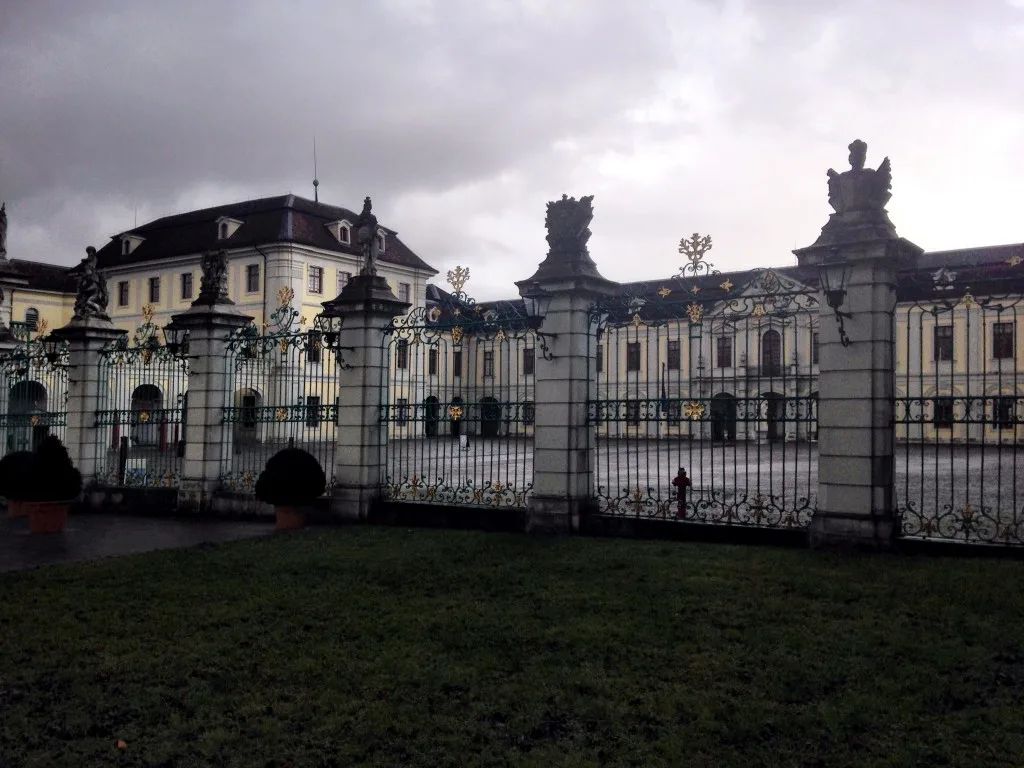
We arrived at the Palace on foot, a short walk from the car park in the center of Ludwigsburg. Our friend, Carmen, had arranged with her friend Gaby, who works at the castle as a guide, to take us through. Gaby turned out to be the perfect hostess. Her infectious sense of humor and vast knowledge entertained us with anecdotes and information we might not have picked up from a more traditional walk-through.
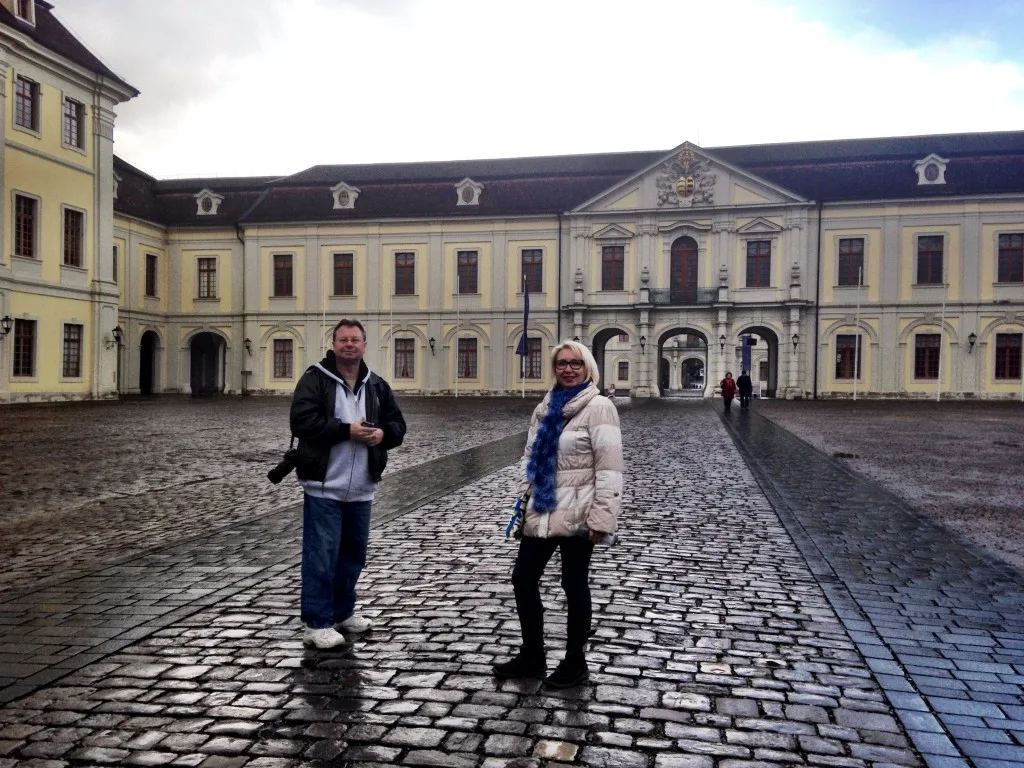
As we wrapped ourselves more closely against the winter’s chill (no central heating in those days), Gaby gave us a quick education on the Palace’s architecture and décor. We would encounter three different styles – Baroque, Neoclassic, and Rococo – as the castle had been added to and remodeled several different times.
These elements combined into a sumptuous and breathtaking décor that was still evident, even though fabrics and furnishings remain in their original, not restored, condition. Rooms of state and private royal apartments alike were draped in fine linens and tapestries, and their lavish furnishings attested to the prestige the palace and its occupants enjoyed. Because of the fragile condition of many of the fabrics and wall coverings, photography inside the Palace is prohibited. As such, unless otherwise attributed, photos in this post come from the castle’s official website.
We were also privileged to tour the old servants quarters in the various wings. These were in vast and stark contrast from the royal environs. Very little light penetrated these cave-like interiors. With the bare minimum of conveniences and depressingly murky atmosphere, the servants’ spaces confirmed the expectation that they were rarely to be seen and even more rarely heard.
Which Ludwig built the Ludwigsburg Palace?
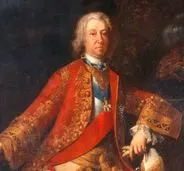
Ludwigsburg’s Ludwig (not to be confused with “Mad” King Ludwig II who built Neuschwanstein Castle, although maybe he really wasn’t insane, but I digress) was actually a Duke. Eberhard Ludwig von Württemberg was appointed as head of the Württemberg state in 1693 at the age of sixteen, thanks to the machinations of his widowed mother on Habsburg Holy Roman Emperor Leopold I.
Heavily influenced, both politically and esthetically, by a visit to Versailles in 1700, Duke Eberhard Ludwig laid the cornerstone of what was to become Residenzschloss Ludwigsburg in the year 1704. The residence was originally planned as a hunting lodge getaway, as the duke left much of his official duties as head of the Württemberg government to administrative advisors in Stuttgart.
In 1718, Eberhard Ludwig established Ludwigsburg as his principal place of residence, and hired an Italian plasterer, Donato Giussepi Frisoni, to act as architect in the palace’s expansion. Frisoni incorporated Baroque elements, connecting galleries, and two pavilions to the original plan. As well, the gardens were redesigned.
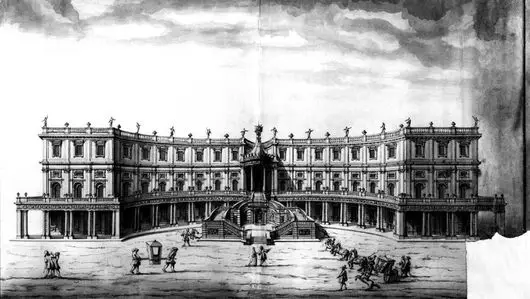
While he admired the power and absolute authority he’d seen wielded by France’s King Louis XIV, Ludwig’s efforts to establish similar oversight in Württemberg faltered. As a result, financial challenges required Ludwig to incentivize workers with free living quarters around the palace over the course of its construction. This housing later became the charming town of Ludwigsburg, which was symmetrically laid out and uniformly built in accordance with Frisoni’s plans. Frisoni,one of Ludwigsburg’s wealthiest residents at the time of the duke’s death in 1733, was later accused and acquitted of embezzlement.
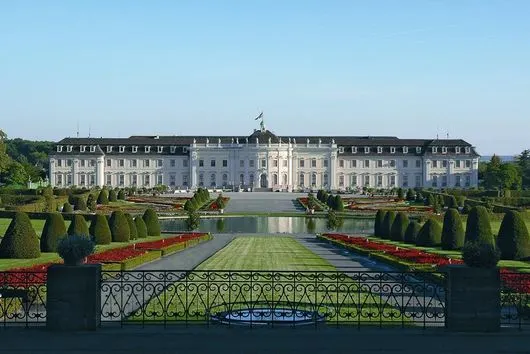
Ludwig’s scandalous personal life influenced the palace’s environs as well. Inside a mirrored cabinet in his bedroom was a secret staircase he used to access the bedroom of his long-time mistress, Wilhelmine von Grävenitz, a commoner he married in 1707. However inconveniently, he hadn’t divorced his first wife, who remained in Stuttgart, forcing von Grävenitz’s exile to Switzerland. The Emperor only allowed her to return once she’d married another man, rendering Ludwig’s bigamy null. Ludwig went on to build a separate smaller palace, the Schloss Favorite (as she was), for Wilhemine. From his private apartments, he could yearningly gaze across the Palace grounds to catch a glimpse of her.
Who was Wilhelmine?
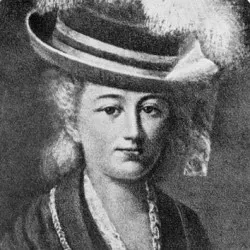
Politically astute, Wilhelmine and her new husband were members of the duke’s “Secret Cabinet” along with receiving other special privileges and financial rewards. Naturally, this did little to endear her to the general public. By 1731, when the duke reconciled with his wife, von Grävenitz was arrested and exiled to Berlin, although allowed to keep many of the financial assets bestowed upon her.
A Baroque Masterpiece
The grand Baroque residence was finished in 1733 and remains the epicenter of Ludwigsburg today. As well, it is one of the largest extant examples of original Baroque buildings in Europe, with over 450 rooms and princely apartments. Duke Eberhard Ludwig’s successors added their personal touches to the palace, particularly Friedrich I, who was made King of Württemberg in 1806 by Napoleon, who had occupied the state militarily six years previously. This appointment and military alliance came at a cost: over 15,000 Württemberg soldiers were sacrificed during Napoleon’s Russian campaign.
King Friedrich, whose English wife Charlotte Mathilde was a daughter of King George (yes, that one), used Ludwigsburg as a summer residence. With Charlotte’s influence, the gardens and royal apartments took on more Classical elements. She was by all accounts a kindly woman with a penchant for domestic arts such as needlework and decorative painting.
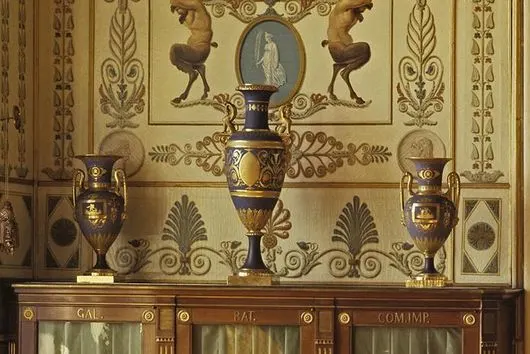
Charlotte’s extensive collection of painted porcelain includes her own work, and can be seen throughout their private rooms. Her summer “work room” is particularly attractive, filled with the necessary light she needed for her embroidery, which adorns much of the upholstery on their Biedermeier and neo-classical furnishings.
“Fat Friedrich” Modernized the Theater’s Details
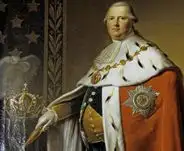
“Fat Friedrich,” as Charlotte’s husband was known, was a man of considerable girth. According to our guide Gaby, Napoleon was said to have remarked that Friedrich was living proof of how far human skin could expand. (!) The bed in Friedrich’s apartment was structurally bolstered to accommodate his weight. This was a detail my brother, who had been an exchange student with our friends, vividly recalled after 30 years.
We especially enjoyed the impressive Schlosstheater, installed by Eberhard Ludwig and modernized by Friedrich in the Classical style. Our friend, Carmen, who volunteers from time to time as an usher at the Schlosstheater when performances are held today, was knowledgeable about many of the theater’s details. The intact mechanical stage machinery was ingenious in its design – it can be operated solely by one person on a rotating axis and is still used. Additionally, the theater still has 16 elaborately painted period set backdrops, which have been meticulously restored.
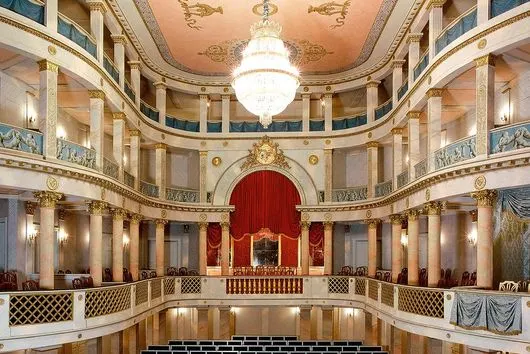
Escorted backstage, we were amused by what must have been sophisticated sound effects in their day, and recreated wind, rain and thunder using these ingenious methods. Then, making our way to the duke’s elaborate box, we imagined the grandeur of attending a performance in days gone by. Gaby was well versed in the nuances of 17th and 18th century court etiquette, which required obsequious deference in accordance with a complicated hierarchical structure of influence. This meant, among other things, elaborate curtsies and flourishes, as well as abrupt performance endings should royals be displeased or out of sorts.
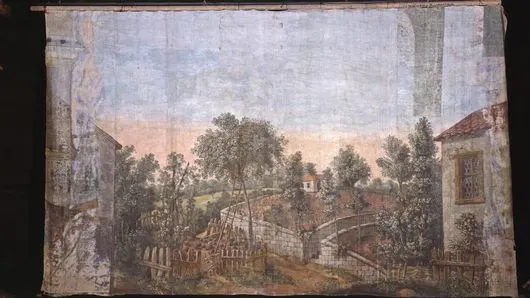
Palace Grounds and Gardens
The beautiful gardens and grounds that surround the palace were delicately and distinctly designed with Italian elements reflecting Frisoni’s esthetic. Meticulous landscaping and a beautiful variety of plants and foliage balance the palace’s symmetry. Friedrich restored the main gardens from neglect beginning in 1798, and then went on to establish two private formal gardens in the English style adjacent to his rooms and those of Charlotte.
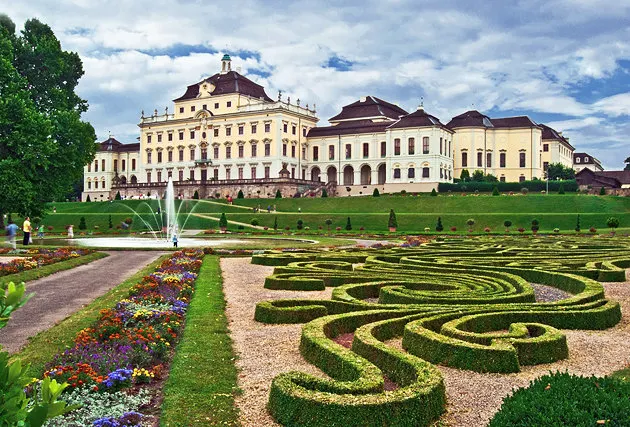
Perhaps the most striking and amusing aspect of Schloss Ludwigsburg’s gardens, however, is the historical Fairytale Garden (Der Märchengarten) and Playground. This must have been the Disneyland of its day. With an artificial castle ruin, a carousel and a playground with swings and water features, this area is a favorite for children of all ages. Vintage mechanical puppets and animated figurines recreate classic fairy tales in a human scale village setting: Rapunzel lets down her hair, Hansel and Gretel approach the witch’s cottage, gnomes point the way, and animals come to life.
The romantic air, magnificent views, original appointments and furnishings, and of course, the Fairytale Garden make Schloss Ludwigsburg a must, even if you might be “castle’d out” from other European experiences. A thoughtful variety of tours are available that will suit your interests, or you can wander the Palace gardens and the Fairytale Garden at your own pace. Schloss Ludwigsburg also has extensive and charming children’s programming that we eavesdropped upon at the end of our visit, with prince and princess dress-up clothing, authentic handicrafts and role-playing that looked like lots of fun!
Where to Stay in Ludwigsburg
Use our interactive map to choose from a variety of places to stay in and around Ludwigsburg:
Tips: Make time to wander the streets of Ludwigsburg adjacent to the Palace, where you’ll see the orderly village layout Ludwig’s architect designed, along with the workers’ residences that are occupied today by lucky Ludwigsburgers. The main square in Ludwigsburg is flanked by Roman Catholic and Protestant churches – reflecting the Reformation’s influence on daily life, each of which has interesting architectural elements.
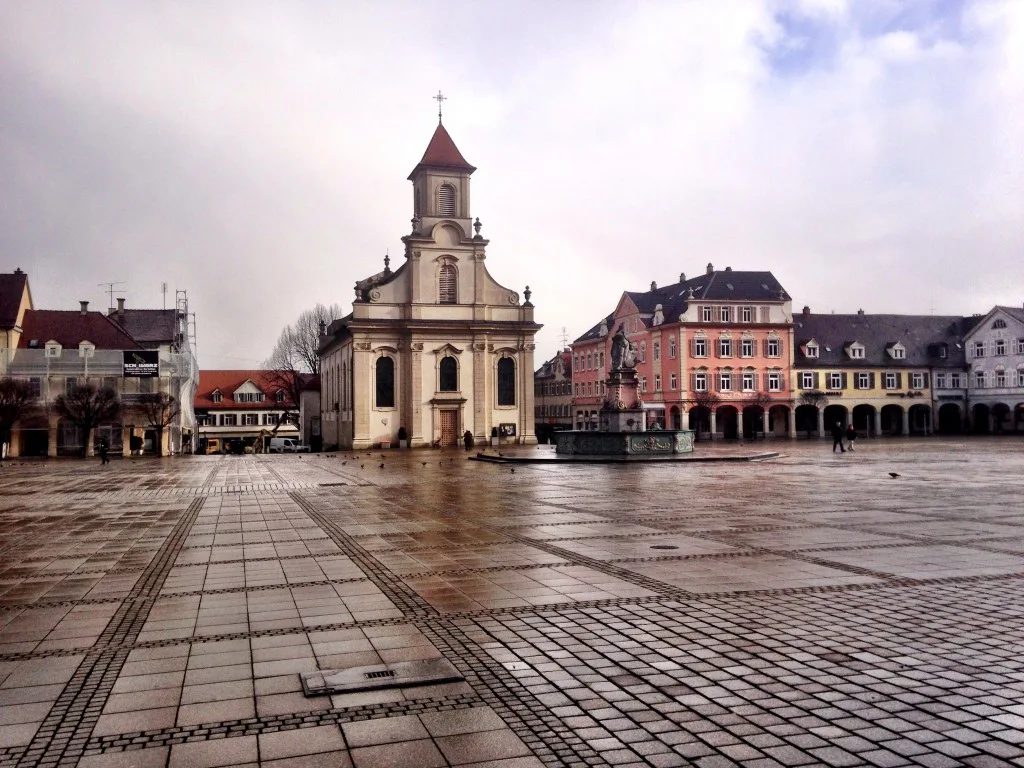
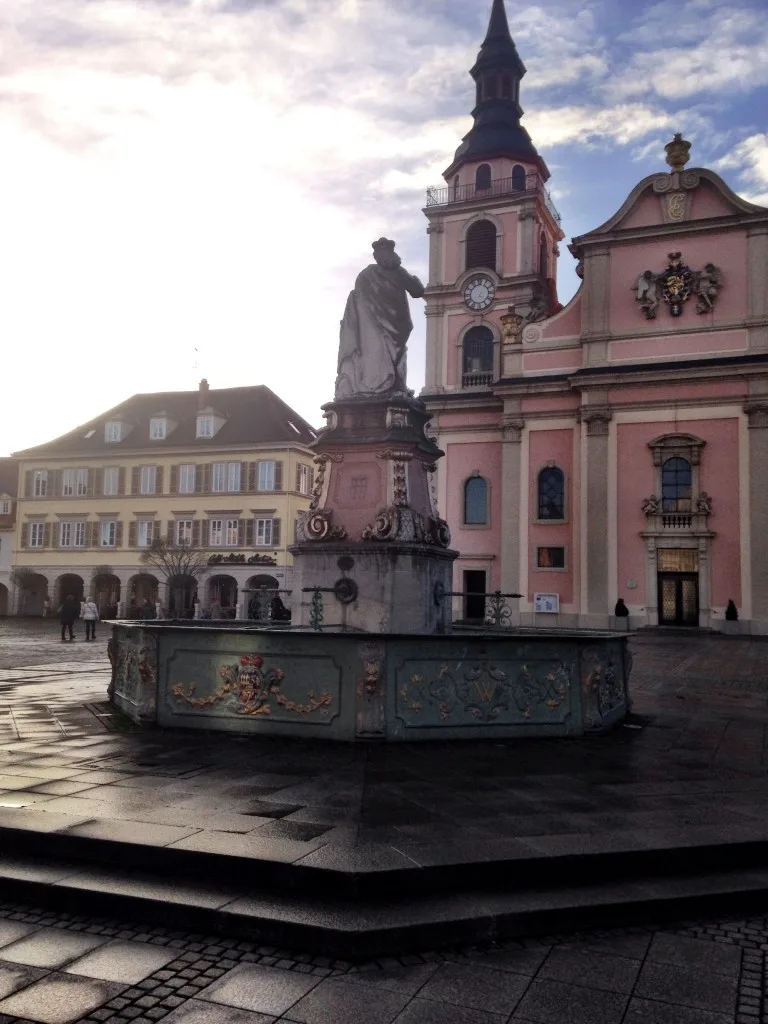
Duck in for a coffee or a cold drink in one of the small restaurants, and look for the delicious apricot liqueur we enjoyed in one of the small specialty shops, where you can dispense it into the decorative bottle of your choosing.
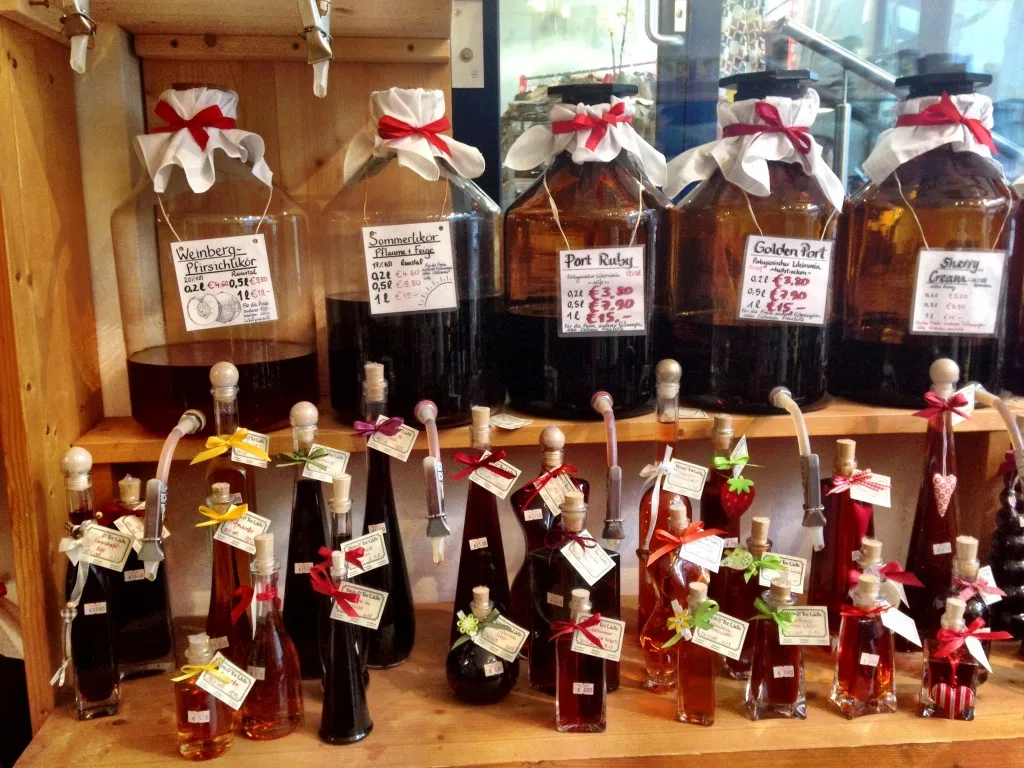
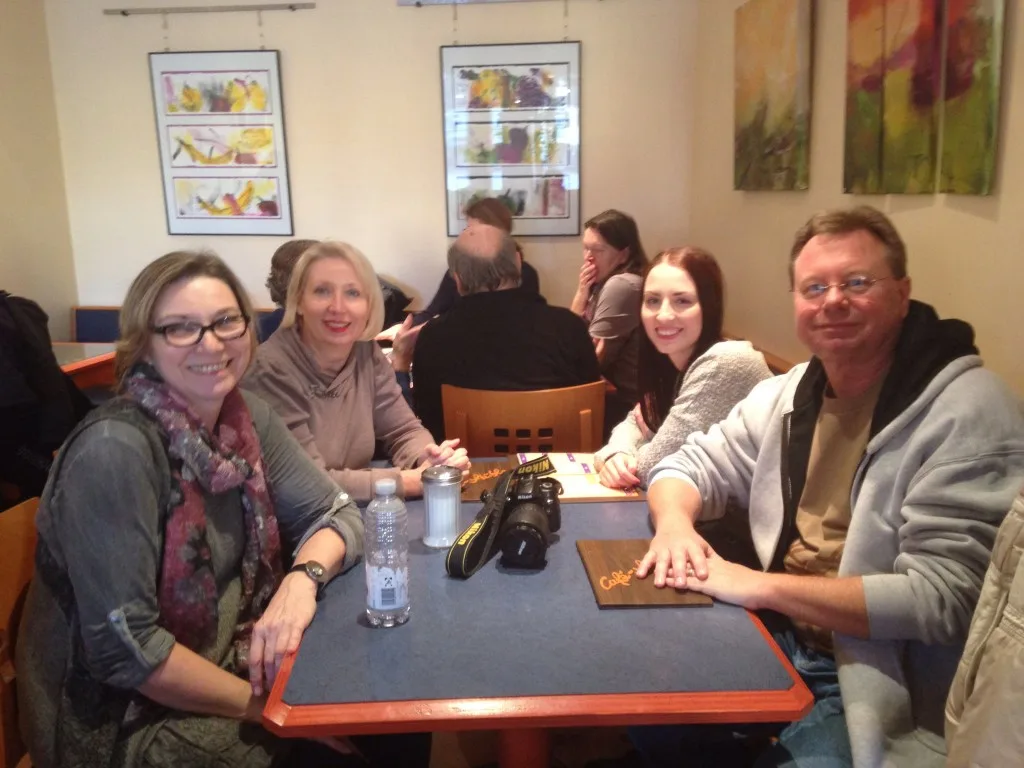
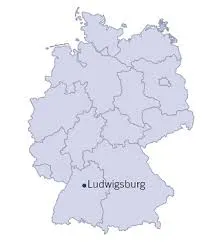
Ludwigsburg is a very quick local train ride from the Stuttgart Hauptbanhof train station. Stay standing, arrival times are very precise and we found out the hard way the train’s doors open and close quickly! 🙂
Other fun sites in Ludwigsburg
Tips for Trip Success
Book Your Flight
Find an inexpensive flight by using Kayak, a favorite of ours because it regularly returns less expensive flight options from a variety of airlines.
Book Your Hotel or Special Accommodation
We are big fans of Booking.com. We like their review system and photos. If we want to see more reviews and additional booking options, we go to Expedia.
You Need Travel Insurance!
Good travel insurance means having total peace of mind. Travel insurance protects you when your medical insurance often will not and better than what you get from your credit card. It will provide comprehensive coverage should you need medical treatment or return to the United States, compensation for trip interruption, baggage loss, and other situations.Find the Perfect Insurance Plan for Your Trip
PassingThru is a participant in the Amazon Services LLC Associates Program. As an Amazon Associate I earn from qualifying purchases.
To view PassingThru’s privacy policy, click here.

Catherine | Fit Armadillo
Saturday 4th of October 2014
More inspiration for our upcoming trip to Germany-I love it! We went to Versailles last year so it would be cool to make the comparison. I definitely remember the punctuality of the trains from my last visit to Germany. I often wish they were like that here in the United States. My question is did you get to see Wilhemine's secret staircase and quarters?! Thanks for sharing :)
Betsy Wuebker
Saturday 4th of October 2014
Bula Catherine - Yes, we did see the mirrored cabinet which had the secret stairway. It makes you wonder how "secret" it really was, though. I'm sure all the servants and certain of the courtiers knew. :)
Cathy Sweeney
Friday 3rd of October 2014
Oh, the castles and palaces of Germany! Ludwigsburg look particularly amazing -- haven't been there. Interesting that is was modeled after Versailles -- much like the other Ludwig -- "Mad" King Ludwig modeled his Herrenchiemsee Palace after Versailles.
Betsy Wuebker
Saturday 4th of October 2014
Bula Cathy - Indeed, it seems as though all these royals wanted very much to live as opulently as possible. Hope you get a chance to visit Ludwigsburg. Next time, we'll chase the "other Ludwig," ourselves. :)
Carole Terwilliger Meyers
Thursday 2nd of October 2014
I've added Schloss Ludwigsburg and Ludwigsburg to my must-do list for next time I am in Germany. Have you ever visited Regensburg? If not, my article about it might interest you, http://berkeleyandbeyond.com/Way-Beyond/Travel-Articles/Abroad/Regensburg-Germany/regensburg-germany.html
Betsy Wuebker
Saturday 4th of October 2014
Bula Carole - Glad we inspired you to add Ludwigsburg. Unfortunately, we had to nix Regensburg on this last trip, but it has a definite spot on our list for next time we're in Germany. It's so close to Prague, we're sure to easily include it with a revisit. :)
Michelle
Thursday 2nd of October 2014
I loved visiting Versailles! Schloss Ludwigsburg looks even more opulent which I didn't think was possible.
Betsy Wuebker
Thursday 2nd of October 2014
Bula Michelle - I think the difference is Versailles seems frozen in time from the events of the revolution, and of course it is restored. In Ludwigsburg, Friedrich and Charlotte's legacy built on that of Eberhard Ludwig's, so it's a multi-generational result with different period styles. Nothing seemed to me to be more opulent than Versailles' Hall of Mirrors, but of course that was a state space, rather than a private apartment. Schloss Ludwigsburg's opulence seemed on a more livable scale, if one can say that about a palace. :)
Irene S. Levine
Thursday 2nd of October 2014
What beautiful photos! Looks very Parisienne!:-)
Betsy Wuebker
Thursday 2nd of October 2014
Bula Irene - I'm sure Ludwig would have loved that observation, seeing as he was so enamored of Versailles. :)